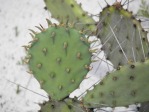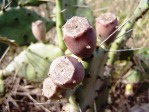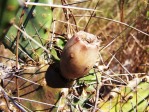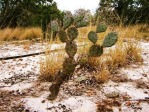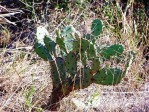
Small, Journal of the New York Botanical Garden 20(230): 29, 1919
Herbarium; Herbarium; Herbarium; Herbarium; Herbarium; Herbarium; Herbarium; Herbarium; Herbarium; Herbarium; Herbarium
See O. austrina, a related cactus
See O. polycarpa, a related cactus
Original Citation
What is Opuntia ammophila?
Opuntia ammophila is a smallish, tree-like prickly pear cactus of lower Florida. The type specimen was from Ft. Pierce on inland sand dunes. Its small size and unique shape make it suitable as a garden plant, but it is not cold-hardy.
Details
Cladodes are obovate or cuneate, varying to elliptic or even oval, and thickish, and unlike the cladodes of other Florida prickly pears, the cladodes are gray-green. Where they join the main trunk, cladodes may be cylindrical. This prickly pear has numerous long, thin spines that may be deflexed or erect on mature pads. There are 1(2) spines per areole that are up to 4(6) cm long.
The flowers are light yellow and the stigma is cream-colored. Bud tepals are distinctly recurved, creating a unique look. This Opuntia has small, thick-obovoid, many-seeded fruits. Seeds are about 4 mm across. Some authors propose that this Opuntia is a form of O. austrina or even O. polycarpa. There are definite similarities; however, for now, we accept it as a stand-alone species. Mature plants have tuberous roots.
Opuntia ammophila is diploid.
Other Notes
O. ammophila was once considered a variety of O. humifusa; however, it is a distinct species of prickly pear cactus. This Opuntia was more commonly found 100 years ago and sometimes grew to the height of humans with thick woody trunks. Britton and Rose reported that O. ammophila typically has a single trunk and can appear tree-like; even small plants may be upright from a single stem. Habitat destruction has limited its range, and today plants in habitat are seldom 1 m tall and often shorter.
For more information, see
Majure, L.C. (2007) Majure, L.C. (2007) The ecology and morphological variation of Opuntia (Cactaceae) species in the mid-south, United States. Graduate thesis, Department of Biological Sciences, Mississippi State University.
Photo credits
All photographs on this page are by Daniel Alfred Green.

